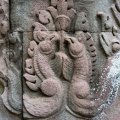
The German Angkor Imagery Project
• G • A • I • P •
The temple dating from 1187 originally was called Rajavihara, meaning "King's monastery" in Sanskrit. The modern Khmer name "Ta Prohm" means "Old Brahma". It sounds more like "Ta Proom" with a short "oo" like in "look".
Ta Prohm, located three kilometres north-west of the Angkor Wat, is famous as Angkor's "jungletemple". If you are in a hurry and have only a few hours to spend in Angkor, this large monument surmounted by many stone-strangling trees, indeed, is one of the three must-sees of Cambodia, apart from the Angkor Wat and Angkor Thom's Buddhist face towers. The early French archaeologists intentionally left it partially unrestored. This is why until the present day enormous strangler figs (Ficus gibbosa) and even huger Thitpok trees (Tetrameles nudiflora) grow from the towers and halls, spreading their gigantic roots over intricately carved stone, thus making Ta Prohm an icon of excellent architecture reconquered by the force of nature. This massive combination of art and vegetation is unique in the world, and one of the impressions nobody will ever forget. In the early morning hours, before first bus groups arrive, you can still listen to the sounds of the jungle when exploring the labyrinthic temple ruins. But after 8.00 am no visitor should expect tranquillity or romanticism in this popular tourist attraction any more. Ta Prohm was even used as a location in the film Tomb Raider.
Ta Prohm was a monastery of enormous dimensions, 65 hectare, the size of some contemporary whole cities in contemporary Europe. According to a temple inscription 12,640 people lived here. Thousands of them were monks, but most of the inhabitants were laymen as supporters, including 615 female dancers. The monastery was enormously wealthy, as it had vast stores of silks, pearls, jewels and gold and was in charge of 3400 villages. It was a state within the state.
Ta Prohm was one of record-builder Jayavarman VII's first major temple projects, only the neighbouring Banteay Kdei is a few years older. The monastery was dedicated to the king's mother, who was identified with the Buddhist female personification of pure wisdom called Prajnaparamita. The even larger Preah Khan, built shortly after Ta Prohm, correspondingly was dedicated to his father identified with saviour Lokeshvara. The northern and southern side temples in Ta Prohm's third enclosure were dedicated to the king's teacher and his elder brother respectively. 260 gods were worshipped in Ta Prohm, too. They were probably represented by movable statues called Utsavamurtis. And many stone carvings of this Buddhist sanctuary depict topics from the Hindu mythology.
Like most other temples, Ta Prohm is oriented to the east. If you have hired your own transport, it is recommendable to start at the eastern main gate and to be picked up at the west gate.
Ta Prohm has some nice sections at any time of the day. However, there are two times, both of them uncommon for temple visits otherwise, to be highly recommended in the case of Ta Prohm. For the real jungletemple experience come at 7.00 in the morning. That's the only chance to hear the sounds of the jungle instead of screams of fellow tourists. Or come during noon, because many busloads leave for lunch, and the sunlight can reach and light up the roots of the trees strangling the jungletemple.
Ernst Ando Sundermann
• G • A • I • P •
Copyright © 2019 khmer-heritage.de